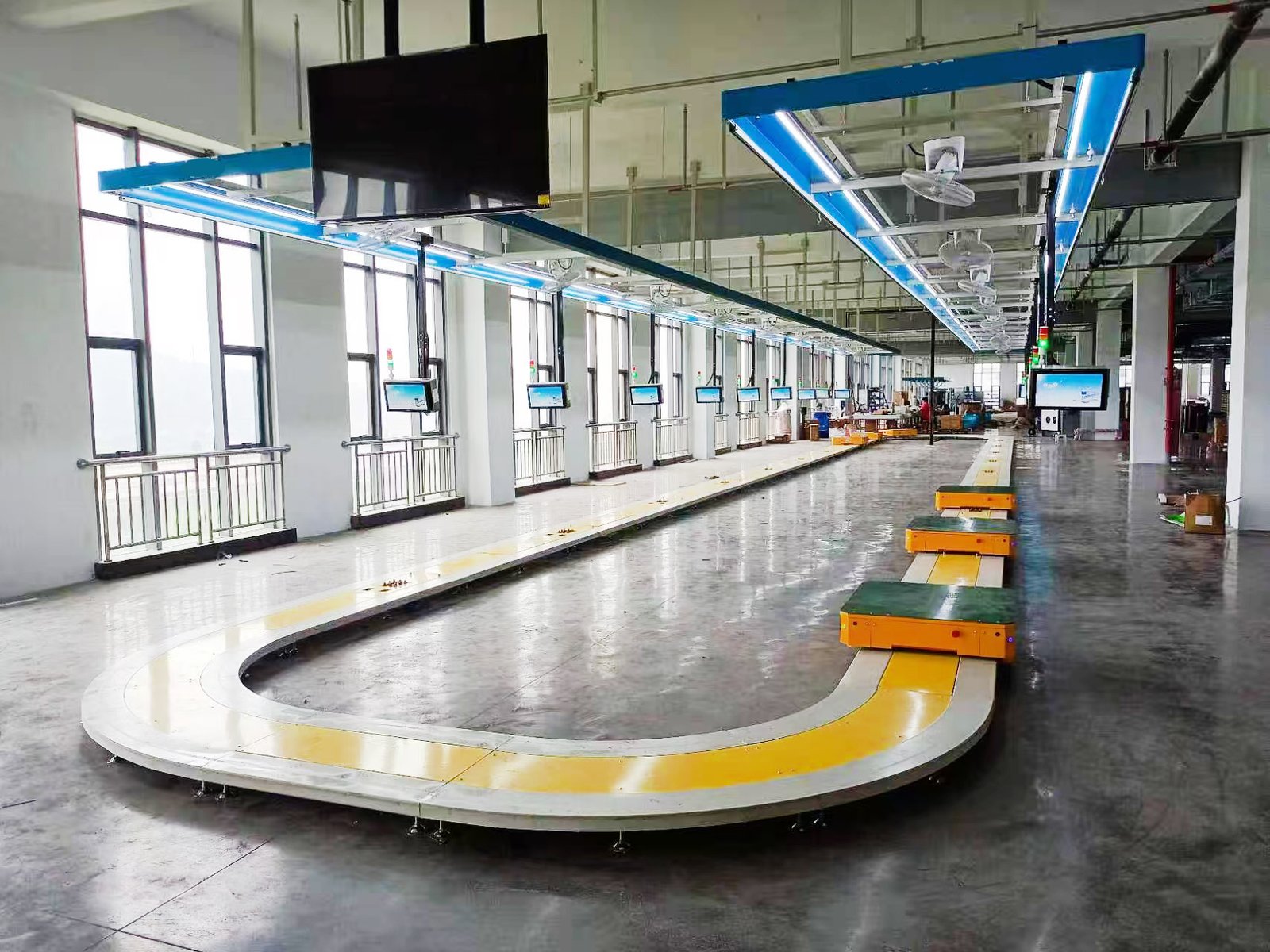A streamlined assembly line equipment designed for small-batch production.

RGV (Rail Guided Vehicle) assembly lines are a type of rigid automated conveying system widely used in modern batch manufacturing. Compared to flexible solutions like AGVs, RGVs offer high speed, high reliability, low cost, and ease of maintenance, making them especially suitable for high-takt, fixed-path, high-precision assembly scenarios such as automotive powertrains, home appliance compressors, electric motors, battery modules, and more.
The following provides a systematic analysis of their characteristics from three perspectives:
I. Electrical Control System Characteristics: PLC-Centered Distributed Control Architecture
1. Control Structure: Master Control + Onboard Sub-Control
- Ground Master Control Cabinet: Uses a PLC or industrial PC as the central controller, responsible for task scheduling, path planning, and interfacing with upper-level MES/WMS systems.
- Onboard Control System: Each RGV is equipped with an independent PLC or embedded controller, which communicates with the ground master in real time via sliding contact lines or wireless, enabling functions like positioning, start/stop, speed adjustment, loading/unloading.
- Multiple control modes: Supports manual/single machine/online modes to adapt to debugging, maintenance, and automated operation.
2. Drive and Positioning Control
- Travel Drive: Typically uses inverter motor + encoder closed-loop control, offering a wide speed range and high positioning accuracy.
- Positioning Methods:
- Laser ranging or barcode strip recognition: for high-precision positioning (±0.05mm);
- RFID tags: for station identification and task triggering;
- Photoelectric/proximity sensors: for limit protection and rough positioning.
3. Power Supply Methods
- Sliding Contact Line Power: Most common, supports long-duration continuous operation, ideal for high-takt lines;
- Battery Power: Suitable for complex paths or areas without sliding lines;
- Rail Power (36V low voltage): Safe, no trailing cables, suitable for areas with frequent personnel access.
II. Deep Integration with MES Systems: Enabling Production Transparency and Traceability
1. Data Exchange Mechanism
- RGVs act as mobile execution units, communicating bidirectionally with MES via PLC:
- Downlink Commands: MES sends tasks (e.g., deliver to station X, vehicle model info);
- Uplink Feedback: RGV reports status (e.g., current position, task completion, fault codes).
- Communication interfaces: Ethernet/RS485/Profinet, supporting standard industrial protocols for easy integration.
2. Key Functionality
- Process Path Control: MES sends process paths based on product models, and RGVs travel to designated stations accordingly;
- Material Traceability: RFID/barcode identifies material and pallet info, enabling batch, station, time, operator binding;
- Error Prevention: MES verifies material-station match to prevent incorrect or missed assembly;
- Andon Integration: RGV status is displayed in real time on electronic boards for visual scheduling.
III. System Integration with Peripheral Equipment: Building a Complete Automated Logistics System
RGVs do not operate in isolation. Their strength lies in seamless integration with upstream/downline equipment of the assembly line, forming a highly integrated automation system:
| Peripheral Equipment | Function | Integration Method |
|---|---|---|
| Roller/Chain Conveyors | Enable automatic material handover between stations | RGV and conveyor use photoelectric signals + PLC interlock for auto loading/unloading |
| Lifts/Elevators | Enable vertical or multi-floor transport | RGV and lift interlock control for vertical transfer |
| KBK Light Cranes | Assist manual assembly or lifting | Coordinated scheduling with RGV: RGV delivers → KBK lifts → RGV returns |
| Industrial Robots | Enable automatic loading/unloading or assembly | RGV acts as mobile platform; robot picks from RGV for assembly |
| Vision/Inspection Systems | Enable quality inspection and recognition | RGV delivers parts to inspection station, triggers vision system |
| Buffer Stations/Accumulation Zones | Enable flexible takt adjustment | RGVs support accumulation, waiting in buffer zones for dispatch |
IV. Typical Application Scenarios and Advantages Summary
| Item | Characteristics |
|---|---|
| Operating Speed | Up to 160 m/min empty, 120 m/min loaded — much faster than AGV |
| Positioning Accuracy | Up to ±0.05 mm, suitable for precision assembly |
| Control Method | Centralized PLC control: stable, reliable, easy to maintain |
| System Integration | Seamless with MES, WMS, robots, conveyors |
| Cost Advantage | Simple structure, uses domestic standard parts — low manufacturing and maintenance cost |
| Safety | Safe sliding contact power, equipped with laser/safety edge dual anti-collision |
| Scalability | Supports circular/linear layouts, flexible to add/remove vehicles |
V. Conclusion: Future Trends of RGV Assembly Lines
Although RGVs are less flexible than AGVs, their high takt, low cost, and high stability make them irreplaceable in standardized high-volume manufacturing. Going forward, with the rise of smart manufacturing, RGV systems will evolve toward:
- Higher precision and intelligence: servo drives, vision guidance, AI scheduling;
- Integration with digital twins: virtual commissioning and operation optimization;
- Modular and standardized design: shorter delivery cycles, lower customization costs;
- Green and energy-efficient: energy feedback, low-power drive technologies.
